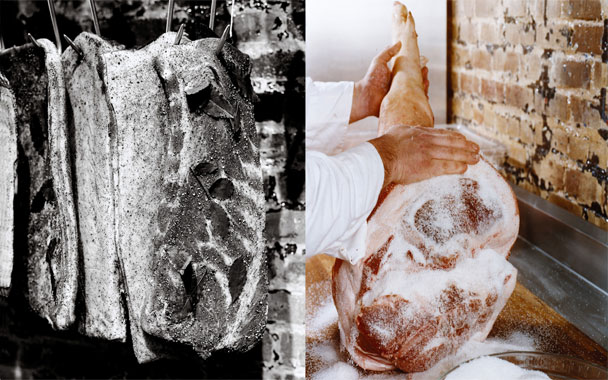Most meals in our house are quick, the result of fast-approaching dinnertime and a fridge full of vegetables. But some things are worth planning ahead. This is why I have pork shanks curing in my crisper drawer.
“Curing” means applying prodigious amounts of salt to a piece of meat and letting it sit. The salt initially draws some water from the meat, suppressing the nasty bacteria that would spoil the fun. Then some of the meat’s proteins break down and water diffuses back in, along with the salt and any other flavorings that happen to be in the vicinity. It’s a very old idea with a million variations.
The pork shanks in my fridge are sitting in a brine made with two parts salt and one part brown sugar, along with garlic, spices (cloves, juniper, peppercorns), and herbs (thyme, rosemary, bay). They’re turning into jambonneaux (“little hams”) following a recipe from the inexplicably out-of-print American Charcuterie, but I’ve used the same technique with different aromatics to turn fresh brisket into corned beef and to make Thanksgiving turkeys more succulent. After five days or a week, when the meat is suffused throughout with herby, salty goodness, the shanks will get poached for an hour or two in a vegetable and white wine broth. Rolled in mustard and bread crumbs, re-heated in the oven, and served with potato gratin or a plate of boiled French lentils—voilà, an instant bistro meal for a rainy spring evening.
But the brine isn’t even necessary—you can just cover your food in a layer of salt and other flavorings and let it sit for a few days, turning it over from time to time. At least once each year I splurge on enough Alaskan salmon to make gravlaks, flavored traditionally with dill and vodka or in some nouveau fashion that strikes in the moment. Even more than brining, dry-curing concentrates and sharpens flavors. The saltiness complements richness, too, and I love to give oily local fish like herring or mackerel a short (half a day or so) dry cure and serve them with something sharp or spicy (like pickled onions).
The logical end result of salt and time are dry-cured hams, made by salting a whole pig’s leg and leaving it to hang at room temperature for a year or more while the slow chemistry develops intensely savory flavors that balance the porky sweetness. I’ve always wanted to make my own hams, but don’t have the space in my apartment. I have, though, become a big fan of the other end of the salt/time spectrum: I now follow Judy Rodgers’s advice and salt my meat a day or more in advance. For big pieces (chops, steaks, or even whole chickens) I’ll use a teaspoon of salt per pound and let things sit uncovered in the fridge for a couple of days. It’s kind of like letting meat rest after cooking, in that it takes virtually no actual working time, but makes things delicious through and through.




 Pinterest
Pinterest


